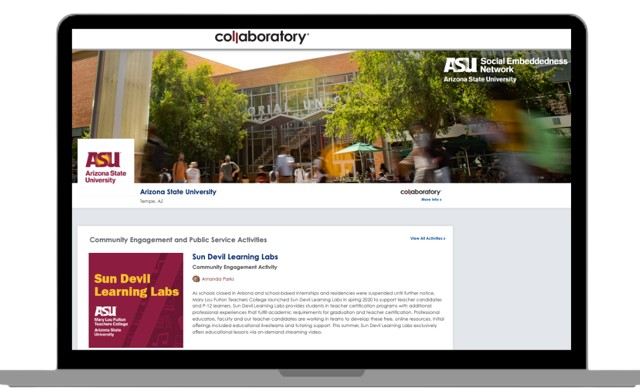Diversity, Equity, and Inclusion (DEI) has been a growing practice within American institutions of higher education, but support for the internal infrastructure and integration with other key areas of institutional priority has fluctuated over time. Throughout the last decade, more focus has been given to DEI (now often expanded to DEIAB – Accessibility and Belonging), specifically in the recruitment and retention of diverse faculty, staff, and students.
When campuses utilize Collaboratory to capture community engagement data, institutions are able to know exactly how and in what ways their faculty, staff, and students are engaging with specific populations, partner organizations, and the roles partners play within engaged activities. Further, campuses are able to effectively parse and pivot their data through various lenses to understand exactly how their institution is working in and with community to address key issues such as DEI, immigration, human rights, etc. When framing data collection and use through a DEI lens, Collaboratory allows institutions to amplify their community-based DEI efforts and more concretely illustrate how community engagement and DEI are deeply intertwined strategies to generate positive change in both the campus and community.
Arizona State University (ASU) employs a multi-level approach to DEI. At the university level, the Office of Inclusive Excellence serves as a hub for coordinating DEI-focused activities across the academic enterprise, as academic and administrative units drive localized DEI efforts within specialized committees. ASU’s commitment to DEI extends beyond campus through collaborations with external organizations and partners. Central to ASU’s charter is a commitment to be fundamentally responsible for the economic, social, cultural and overall health of the communities in which it is socially embedded, deeply rooted in its place as a vital anchor institution in the local community and beyond (Social Embeddedness).
Collaboratory plays a pivotal role in ASU’s assessment and evaluation of their DEI and social embeddedness efforts. Collaboratory data allows ASU to pinpoint successes while also identifying geographical or thematic gaps to drive a more targeted approach. ASU utilizes Collaboratory to foster accountability and transparency, offering an objective view of progress and outcomes which guides informed decision-making (e.g., resource allocation, program development, strategic planning). Furthermore, the public aspect of Collaboratory allows ASU to easily showcase their commitment to social embeddedness and DEI, allowing all to see the tangible impact of their faculty, staff, students, and community partners.
To illustrate the strategic and focused efforts of ASU to advance an integrated and data-driven approach to DEI and social embeddedness, Catalina Monsalve, Project Manager for Inclusive Excellent within ASU’s Office of the University Provost shared her insights. In her role, Catalina helps advance a variety of projects that align with the ASU Charter such as the HSI/Excelencia, working collaboratively across the enterprise. Catalina also utilizes data, such as Collaboratory data to access and demonstrate the impact of various and collective projects. By leveraging Collaboratory, Catalina provides insights into the effectiveness of their programs, ensuring they align with ASU’s institutional goals.
Assessment and Improvement
Data allows us to assess the effectiveness of our CE and DEI initiatives. By capturing metrics, we can identify areas of success and areas that require improvement, enabling a more informed and targeted approach.
Accountability and Transparency
By understanding the patterns and trends in community engagement and DEI efforts, we can make informed decisions on resource allocation, program development, and strategic planning.
Demonstrating Impact
Data serves as a powerful tool for storytelling. It enables us to demonstrate the real-world impact of our initiatives to stakeholders, senior leaders, and the broader community. This, in turn, strengthens support for ongoing and future efforts.
Collaboration between Social Embeddedness and DEI has been expanding. The collaboration seeks to integrate social embeddedness practices into community development, ensuring that these efforts are inclusive and equitable. The collaborations aim to align the two offices with the ASU Charter, recognizing the importance of fostering inclusive communities through embedded social initiatives.
Note: Catalina works closely with Christina Ngo, the Executive Director of the Social Embeddedness (SE) in the Office of University Affairs.
Inclusive Social Embeddedness Initiatives:
Community development efforts that specifically target marginalized or underrepresented communities, integrating social embeddedness principles for a more inclusive impact.
Equitable Access to Resources:
DEI initiatives within social embeddedness, working to ensure that resources and opportunities are distributed equitably, addressing systemic barriers that may hinder access for certain groups.
Impact Measurement with a DEI Lens:
Social embeddedness initiatives collaborating with DEI experts to develop and implement impact measurement frameworks that consider the diverse outcomes and benefits for different communities.
As a project manager within the Office of Inclusive Excellence, aligning my work with institutional priorities involves a strategic and collaborative approach. By weaving social embeddedness and DEI efforts into the fabric of institutional priorities and values, the work contributes not only to the community’s well-being but also strengthens the institution’s commitment to positive social impact and inclusive excellence.
Data-Driven Decision Making
Utilizing data (including Collaboratory data) to identify areas where there are potential gaps, or areas of opportunity where social embeddedness can have a significant impact on institution and community-identified priorities (e.g., resource allocation).
Strategic Partnerships
Fostering strategic partnerships with community organizations, businesses, and other stakeholders that align with institutional priorities. These collaborations enhance the reach and effectiveness of ASU’s social embeddedness efforts.
Incorporating DEI Principles
Infusing DEI principles into social embeddedness initiatives to ensure that ASU’s community-focused work not only aligns with institutional priorities but also contributes to creating a more inclusive and equitable community.
Continuous Communication
Maintaining open lines of communication with relevant departments and stakeholders to ensure that community engagement initiatives remain aligned with any evolving institutional priorities.
Want to Learn More About Collaboratory?
If your institution is interested to learn more about how to leverage Collaboratory to better align community engagement and DEI initiatives, email info@cecollaboratory.com.


